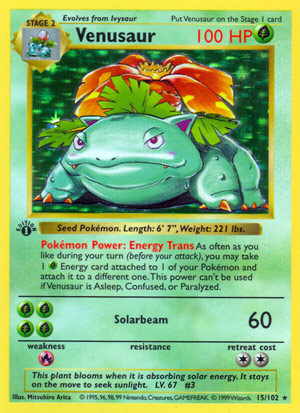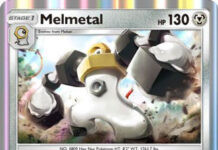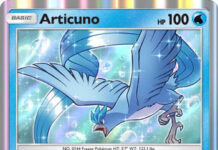
Venusaur – Base Set
Date Reviewed: December 2, 2021
Ratings Summary:
Standard: N/A
Expanded: N/A
Ratings are based on a 1 to 5 scale. 1 is horrible. 3 is average. 5 is great.
Reviews Below:

Otaku
Another Throwback Thursday focused on one of the doesn’t-change-its-legality reprints from Celebrations: Venusaur (Base Set 15/102; Base Set 2 18/130; Legendary Collection 18/110). The Celebrations print is based on the Base Set release, but is obviously distinct thanks to the 25th Anniversary stamp on the card. I’m going to start with what made Venusaur famous back in the day, its Pokémon Power. For those unfamiliar with the term, Pokémon Powers are the original non-attack-effect for Pokémon. They were later broken down into two subcategories (Poké-Bodies and Poké-Powers), and eventually completely replaced by Abilities.
Energy Trans lets you move a [G] Energy card attached to one of your Pokémon to another of your Pokémon, as often as you want. Well, slight caveat in that I believe they long ago ruled you couldn’t just waste time moving Energy back and forth over and over again. Energy Trans works with both basic Energy and Special Energy cards, with cards that provide only unit unit of Energy or those that provide multiple, and even those that provide multiple Energy types so long as one of those types is Grass. We’ve had many effects like this for the last two-and-a-half-decades of the TCG. Sometimes, they find themselves among the top decks of the metagame. Sometimes, they’re only worth playing for fun. Of course, they can fall somewhere in between as well.
Venusaur’s Energy Trans stops working if it is afflicted with a Special Condition. Yes, I know the card only mentions Confusion, Paralysis, and Sleep. “Special Conditions” was a concept that didn’t happen until a few years into the TCG. Once the change was in the works, players were told that
- …from then on, Poison would shut off Pokémon Powers that already said they were shut off by the Pokémon being Asleep, Confused, or Paralyzed.
- …all four of these status ailments would henceforth be referred to as “Special Conditions”.
- …”Burned” would join them soon, once the first sets utilizing that mechanic were released.
- …other existing attack effects did not count as Special Conditions, only the five specifically named.
Energy Trans decks were definitely a thing even in the days of Base Set-only play. After all, they had access to:
- Pokémon Center, with its original “Max Potion for all of your Pokémon” effect on a “normal” Trainer, what we’d now call an Item card.
- Scoop Up, another normal Trainer (Item) that let you select one of your Pokémon in play, then return the Basic Stage of that Pokémon to your hand while discarding any and all other attached cards.
- Electrode (Base Set 21/102; Base Set 2 25/130). Its “Buzzap” Pokémon Power KO’d itself, had you discard all cards attached to Electrode (even the Voltorb from which it had Evolved), pick an Energy type, and finally attach it to one of your Pokémon as s Special Energy card that provided two units of the selected type. So, you could use it to give yourself a [GG] Energy card you could move around! However, while Venusaur decks saw a decent amount of play, in hindsight they were at best barely competitive.
While this seems like a solid start, we need to discuss the rest of Venusaur. Its [G] typing was fine: not a big help, but not a problem, either. What was a problem was being a Stage 2 Pokémon. The available Bulbasaur and Ivysaur cards were not good. While there was no Rare Candy, there was the original version of Pokémon Breeder… which worked the same as the modern day Rare Candy. Venusaur had 100 HP; a large amount for the time, but a little low for a Stage 2. [R] Weakness was a problem, as there were some at least sort of competitive Fire decks. No Resistance was still the norm back then, but inexperienced Otaku thought it was a bad thing. A Retreat Cost of [CC] was neither low enough to be good nor high enough to be bad; thankfully, Switch also debuted in Base Set!
This alone probably doesn’t sound too bad. While I could then tell you “But Haymaker…”, I can actually get a bit more specific. The Achilles’ Heel of Energy Trans decks were Bulbasaur (Base Set 44/102; Base Set 2 67/130; Legendary Collection 68/110), Energy Removal, and Super Energy Removal. Yeah, three glaring lower-case-w weaknesses. Bulbasaur had just 40 HP. Thanks to Bill (before he became a Supporter), Computer Search (before it became an Ace Spec), and Professor Oak (Professor’s Research as an Item card), it wasn’t too hard for the typical aggressive, beatdown style deck to dig for Gust of Wind and multiple copies of PlusPower. Enough that a FTKO of Bulbasaur was a real threat. Even if you went first, you’d likely lose one Bulbasaur before your second turn; if you went second, you could lose up to two! Remember, back when the game was new, the only First Turn Rule was “no evolving” and it applied to both players’ first turns.
Energy Removal and Super Energy Removal were also massive problems. The only Energy acceleration available to Energy Trans decks was the Electrode I mentioned. You didn’t want to wait a turn to evolve Voltorb into Electrode, give up a Prize as it self-KO’d, only to get a single turn’s use out of it because your opponent used an Energy Removal to discard it. Even if you’d been manually building up several basic Grass Energy cards over multiple turns, an opponent could wipe it all out in a single turn! While not as devastating, another major problem was an opponent capable of OHKOing your Active, attacking Pokémon. The Energy transferring tricks don’t work if the Pokémon with a lot of Energy are KO’d, their Energy joining them in the discard pile.
According to Ness, the first expansion (second set) of the game, Jungle, changed this. Jungle gave us better Basic Grass attackers like Pinsir (Jungle 9/64, 25/64; Base Set 2 29/130) and Scyther (Jungle 10/64; 26/64; Base Set 2 17/130; Platinum 130/127). Plus a few more tricks that you can read in his excellent write up. I will point out that by this time, everyone knew Electrode and its Buzzap weren’t worth it. Who knows, maybe I was one of the few foolish enough to even try that combo. I believe this deck was just barely competitive, as most of the other problems remain… but I haven’t come back to this Format decades later, while being one of the best players of the game, to test it. So… yeah, my money is actually on his take, not mine.
Venusaur decks didn’t like the Fossil expansion. Muk (Fossil 13/62, 28/62; Legendary Collection 16/110) had its “Toxic Gas” Pokémon Power that turned off all other Pokémon Powers. Muk could hit the field by your opponent’s second turn, and unlike say Blastoise (Base Set 2/102; Base Set 2 2/130), that one turn you could still safely use Energy Trans wasn’t going to let you set up one solid attacker, let alone two. I’d forgotten (thank you, Ness) that the next non-reprint set (Team Rocket) brought the deck back. Mewtwo (WotC Black Star Promos 3, 14) released not too long after Fossil and before Team Rocket, but Team Rocket gave us Rainbow Energy. Rainbow Energy seems obvious for Energy Trans decks, but Mewtwo was not only a great attacker back then, but the counter the deck needed for Muk. Mewtwo could get itself up and running even if Muk was already in play, and it could also OHKO Muk due to Muk’s [P] Weakness.
Gym Heroes and Gym Challenge were not helpful for Venusaur. I think. I’m going by what Jason Klaczynski says on his site about the matter, or rather, doesn’t say. I’d actually stopped playing the TCG during this period, due to a misunderstanding fueled by someone telling me the Gym expansions were their own separate game. While I was gullible, this was probably a year or so before I had regular, reliable dial up internet access. I didn’t exactly have a good way of fact-checking what I was told. For this series of articles I’ve been referencing, Ness has been good at listing decks if they were even a little competitive or even just fun to play at the time, and there’s no mention of this Venusaur…
…but there is an updated entry for it in the next section, covering the Prop 15/3 period. You can get the full explanation of what this Format was from Jason’s site. If you can’t or won’t, just know that it was the last-ditch effort to salvage the Pokémon TCG’s metagame before they resorted to set rotation and it didn’t last long. In the Unlimited Format, and for some of the Modified (Standard) Formats where being reprinted in Legendary Collection returned Venusaur to legality, it could still be enjoyed in some fun decks, but that seems to be it for its competitive days.
Given that more recent Energy Trans decks haven’t done as well when almost identical Abilities were on Stage 2 cards, sometimes not even for Stage 1 Pokémon sporting them, I don’t think an update of Venusaur would be worthwhile in the modern game. Venusaur was a fun deck to play at times in the past, and sometimes even a competitive one.
Ratings
- Standard: N/A
- Expanded: N/A
We would love more volunteers to help us with our Card of the Day reviews. If you want to share your ideas on cards with other fans, feel free to drop us an email. We’d be happy to link back to your blog / YouTube Channel / etc.
Click here to read our Pokémon Card of the Day Archive. We have reviewed more than 4700 Pokemon cards over the last 21+ years!




